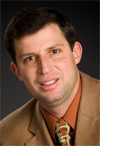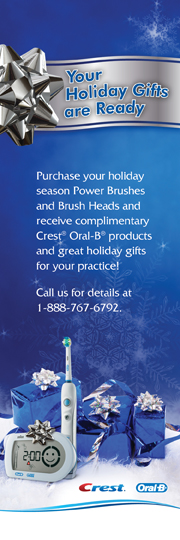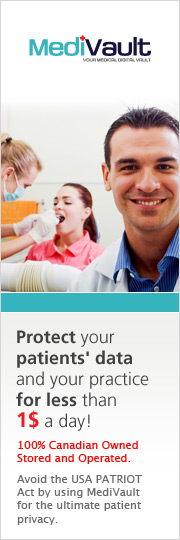A member service that keeps you up-to-date on important new literature relevant to your practice.
 |
|
In this issue of JCDA Express our contributors highlight articles on fissure sealants, dental floss efficacy, pacemakers and dental units, and bisphenol A.
JCDA would like to gratefully acknowledge the publishers of these articles, who have granted free access to the full-text papers until December 16, 2010. Follow the links in the Notes and News sidebar to discover more about these publications.
You can now access the current and archived editions of JCDA Express at JCDA.ca. Recent additions to our website include new practical resources for dentists created by CDA's Committee on Clinical and Scientific Affairs. Two guidance documents and FAQs on medical devices and transplant materials used in dentistry are quick reference guides for practising dentists.
Remember to subscribe to the JCDA.ca RSS feed or follow JCDA.ca on Twitter at: JCDATweets. These tools help keep you informed when new clinical and scientific material is posted to JCDA.ca. Also, please tweet or send me an email with topics you would like to see covered in future editions of JCDA Express.
Yours sincerely,
Dr. John P. O'Keefe
Editor-in-chief
jokeefe@cda-adc.ca
|
|
 |
|
|
Fissure Sealants

Dr. Daniel Boyd is an assistant professor of biomaterials in the department of applied oral sciences at Dalhousie University's faculty of dentistry. Dr. Boyd recommends:
Yengopal V, Mickenautsch S, Bezerra AC, Leal SC. Caries-preventive effect of glass ionomer and resin-based fissure sealants on permanent teeth: a meta analysis. J Oral Sci. 2009;51(3):373-82.
View full text of this article
Full-text access to this article has expired.
Key points:
-
This article advocates the view that the primary measure of success for fissure sealant programs should be based on caries prevention rather than proxy variables such as retention.
-
On this basis, the authors reviewed evidence on the efficacy of glass ionomer cements (GICs) and resin-based composites for use as fissure sealants.
-
A literature search captured 9 English- and 2 Portuguese-language databases. Of the 112 articles identified by the search, 11 met the inclusion criteria (8 trials and 3 systematic reviews).
-
Using a meta-analysis methodology, the authors found that GICs and resin-based composites both had a significant caries preventive effect.
-
Significantly, the authors contend that there is no evidence indicating that either material is superior to the other in the prevention of caries. Therefore, both materials appear to be equally suitable for clinical application as a fissure sealant material.
-
However, the article has an acknowledged limitation. High-viscosity GICs, recently used as fissure sealant materials, were not captured in the review. The authors note that high-viscosity GICs appear to offer a higher sealant retention rate in pits and fissures compared to low viscosity GICs (72% vs. 50% retention rate after 3 years).
-
Based on the analysis of the primary biological outcome (caries prevention), the authors identify a need for additional high-quality randomized control trials to further evaluate the efficacy of GICs and resin-based composites as fissure sealants.
Reasons for recommending this article:
The authors present a thought-provoking challenge to clinicians—that the success of fissure sealant programs should be based on the primary biological outcome of caries prevention, rather than the mainstream proxy measure of retention. In light of the article’s significant findings (that neither GICs nor resin-based composites appear to be superior), Dr. Richard Niederman of the Forsyth Institute provided a commentary1 in a recent edition of Evidence-Based Dentistry, in which he concludes that given the beneficial features of GICs compared to resins (e.g., amount of fluoride released, enhanced pit and fissure penetration due to their less viscous nature and their moisture-forgiving quality), clinicians will likely “see a 10-year change in recommendations away from resin toward glass for sealant programs.”
Reference
-
Niederman R. Glass ionomer and resin-based fissure sealants–equally effective? Evid Based Dent. 2010;11(1):10.
|
|
 |
|
|
|
Dental Floss and Plaque

Dr. Carlos Flores-Mir is director of the orthodontic graduate program and head of the orthodontic division at the University of Alberta. Dr. Flores-Mir recommends:
Berchier CE, Slot DE, Haps S, Van der Weijden GA. The efficacy of dental floss in addition to a toothbrush on plaque and parameters of gingival inflammation: a systematic review. Int J Dent Hygiene 2008;6(4):265-79.
View full text of this article
Full-text access to this article has expired.
Key points:
-
The use of dental floss in addition to proper toothbrushing has long been considered the standard of care to maintain optimal dental and periodontal health.
-
Although it may be beneficial in individual cases, the authors of this systematic review conclude that the scientific facts do not support everyday use of interproximal floss in addition to manual toothbrushing for everyone.
-
This is a controversial conclusion that needs to be considered with caution.
-
The methodology used in this review has some limitations. In particular, the authors analyzed the baseline and end-point data separately, rather than analyzing the differences over time—which is the standard statistical approach.
-
Other limitations include heterogeneity between studies, the inconsistent measurement of outcomes (e.g., plaque, bleeding and gingivitis), which makes it difficult to combine all the available data in the meta-analysis, and no evaluation of real-life conditions.
-
Considering these limitations, it remains appropriate for dental professionals to continue tailoring oral hygiene instructions for patients. These instructions may or may not include interproximal flossing in addition to toothbrushing. In this sense, dentists should determine the specific flossing regime that provides each individual patient with the best possible result.
Reasons for recommending this article:
Evidence-based dentistry is increasingly being considered in everyday clinical decision-making. Systematic reviews provide a methodologically sound summary of the best available evidence. Although systematic reviews generally confirm accepted clinical approaches, they can sometimes reach conflicting conclusions that challenge the way we practise dentistry. This review on the efficacy of dental floss in addition to toothbrushing is a prime example of such a challenging conclusion. Although methodological weaknesses were identified, the errors were not so extreme as to render this a meaningless review. Therefore, despite its conclusions being supported by limited evidence, the review should serve as a reminder that personal treatment planning, should always be based on the individual patient's needs.
|
|
 |
|
|
Pacemakers and Dental Units

Dr. Chris McCulloch is Canada Research Chair and professor with the Matrix Dynamics Group at the University of Toronto's faculty of dentistry. Dr. McCulloch recommends:
Roedig JJ, Shah J, Elayi CS, Miller CS. Interference of cardiac pacemaker and implantable cardioverter-defibrillator activity during electronic dental device use. J Am Dent Assoc. 2010;141(5):521-6.
View full text of this article
Full-text access to this article has expired.
Key points:
-
This in vitro study suggests that dental curing lights and ultrasonic scalers have the capacity to alter the electrical pacing activities of implantable cardioverter-defibrillators (ICDs) and pacemakers, when the dental units are held sufficiently close to the pacemakers (i.e., 6–9 inches away).
-
However, this study does not show whether this interference of intended electrical activity also occurs in vivo—obviously a more complex, but potentially feasible, clinical study.
-
The extent to which muscle, soft connective tissue and blood, or encasements around the pacemaker or ICD itself, can shield the possible interference of the intended electrical activity from these dental units is still unknown.
-
It would seem prudent for dentists to consult with local cardiologists or with physicians in charge of local pacemaker clinics to determine the potential risk of harm to patients with pacemakers or ICDs who receive treatment that involves the use of electronic dental devices. This should be considered on a patient-specific basis.
-
The observations reported in this JADA study are interesting and may provide the impetus for a larger (and possibly in vivo) study to more clearly determine risk and which dental units, operated at particular distances from patients, may actually affect pacemaker or ICD activity and, therefore, cardiovascular function.
Reasons for recommending this article:
Pacemakers and ICDs are increasingly being used for management of cardiac arrhythmias, particularly in elderly patients. Recent data indicate that dental curing lights and ultrasonic scalers can cause loss of normal pacing activity in vitro, if the dental devices are held sufficiently close to the pacemakers. Dentists are encouraged to be aware of this possible malfunction and to consult with the family physician or cardiologist of patients with such cardiac devices in order to make informed clinical decisions.
|
|
 |
|
|
Bisphenol A

Dr. Rocio Quinonez is a clinical associate professor in the department of pediatric dentistry and pediatrics at the University of North Carolina's Schools of Dentistry and Medicine. Dr. Quinonez recommends:
Fleisch AF, Sheffield PE, Chinn C, Edelstein BL, Landrigan PJ. Bisphenol A and related compounds in dental materials. Pediatrics 2010;126(4):760-8.
View full text of this article
Full-text access to this article has expired.
Key points:
-
This article reviews the literature relating to the presence of bisphenol A (BPA) in dental materials, assesses the potential health risks to patients of BPA exposure from such materials, and gives practical guidance for clinicians about reducing potential BPA exposure.
-
Dental resins are composed primarily of BPA derivatives, such as BPA glycidyl dimethacrylate (bis-GMA) and BPA dimethacrylate (bis-DMA), rather than pure BPA. However, BPA may be found as an impurity in some dental resins.
-
Trace amounts of BPA have been detected in saliva after resin placement as a result of the hydrolysis of bis-DMA by salivary enzymes. The presence of BPA in saliva is transitory and of short duration (usually less than 3 hours) after resin placement. Bis-GMA does not undergo this hydrolysis reaction.
-
Some precautionary measures can be taken to reduce the possible transitory exposure to trace amounts of BPA immediately after placement of resin-based sealants or composites. These measures include rubbing the surface monomer layer with pumice on a cotton roll; having the patient rinse for 30 seconds then spit; rinsing the area thoroughly with an air-water syringe.
-
The use of proper isolation, including a rubber dam, may further prevent the potential for exposure.
Reasons for recommending this article:
Because the Canadian federal government declared BPA a toxic substance in October 2010, and because the media often mentions resin restorations and fissure sealants as possibly containing BPA or BPA derivatives, dentists can anticipate more questions from parents about the safety of these materials. The Pediatrics article provides a good summary of the state of the science relating to the safety of dental materials that may contain BPA derivatives.
|
|
|
|
|

JCDA is the authoritative written voice of the Canadian Dental Association, providing dialogue between the national association and the dental community. It is dedicated to publishing worthy scientific and clinical articles and informing dentists of issues significant to the profession.

|

|

|

|
NOTES AND NEWS
Check out the publications featured in this issue
Journal of the American Dental Association
(publisher: American Dental Association)
Journal of Oral Science
(publisher: Nihon University School of Dentistry)
International Journal of Dental Hygiene
(publisher: Wiley-Blackwell)
2011 CDA convention: See you in Halifax in August
The next CDA convention will take place in Halifax, August 4-6, 2011. The theme of the convention is “Navigating Tomorrow—New Visions, Historical Foundations.” Registration, hotel and social program details have now been added to cdaconvention2011.com.
Audiovisual presentations on JCDA.ca
Hardwick F. How do I perform a first dental visit for an infant or toddler? J Can Dent Assoc2010;76:a145.
Search the JCDA Classified Ads
Looking for employment? Want to sell your practice? Classified ads offer the most effective way to reach all dentists and students in Canada.
Spread the word
Help spread the word about JCDA Express by telling your colleagues about it and reminding them to send CDA their email address.
reception@cda-adc.ca
|
|
|

|

|
|





